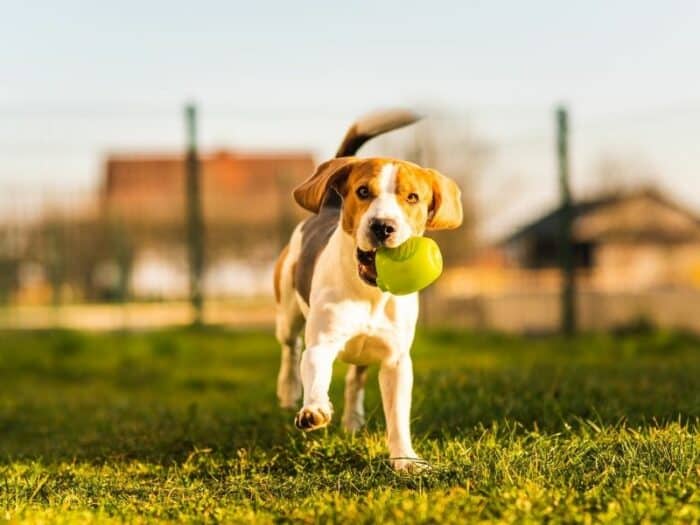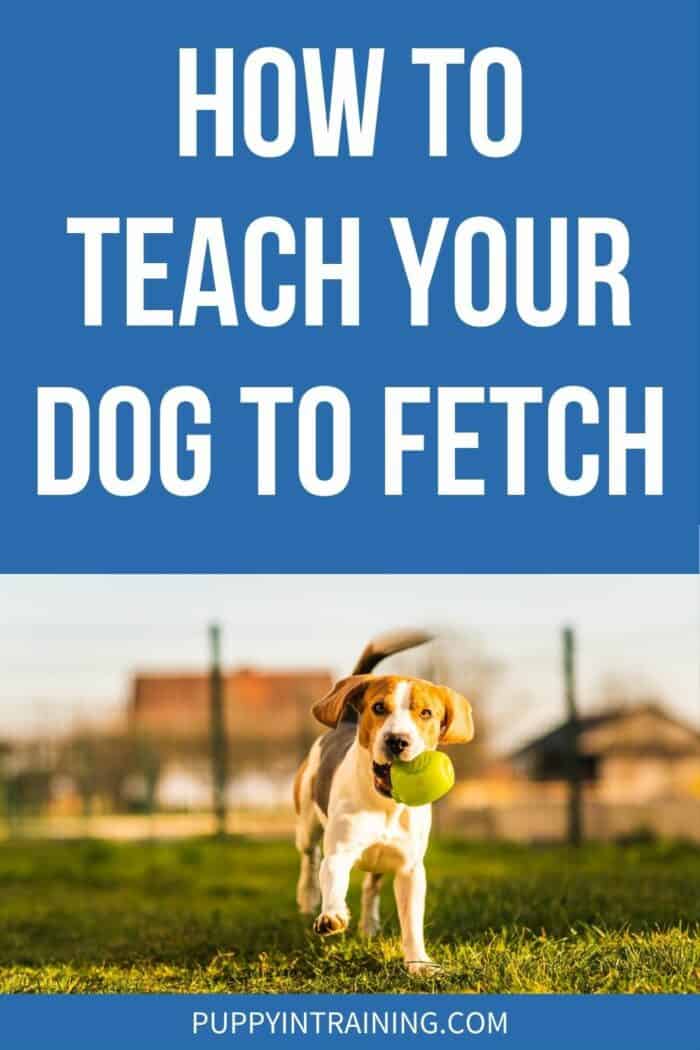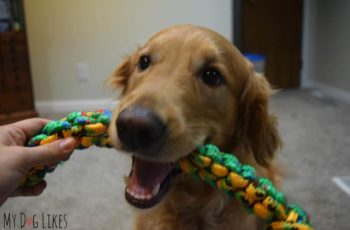This post may contain affiliate links. We may earn money or products from the companies mentioned in this post.
Playing with our dogs is so much fun! Some dogs love to play tug whereas others like to fetch. But what if your dog doesn’t retrieve a toy? How do you teach dogs to fetch?
Don’t despair! Many dogs love to play with toys but aren’t natural retrievers.
Some of my dogs didn’t naturally bring toys back to me. But, teaching dogs to fetch can be done with training and persistence.

Even my shih tzu Cuddles, who didn’t naturally retrieve, learned to gleefully bring her toys back to me after I’d thrown them.
Playing fetch helps exercise your dog and increases your bond.
In this article, I’ll describe how to get your dog to take and hold a toy as well as to retrieve it to you. As is true of all training, it takes patience, persistence, and consistency to be successful.
Article Summary
- Fetching a toy can be a great way of providing mental and physical exercise for your dog. It also can further the bond you have with your furry friend.
- Of course, some dogs are natural retrievers. But if your dog isn’t, there are ways you can teach him to play fetch, which are described in this article.
- You should keep the game fun and rewarding, do short training exercises, and always end on a successful note.
Be Prepared!
Before teaching your dog to fetch, have all the supplies that you’ll need ready.
Of course, you’ll need a toy that your dog can’t resist. Each dog’s an individual and has his own likes and dislikes.
Most dogs love soft, plush, stuffed toys that squeak, crinkle, or rattle. Others love rope toys or balls.
They even make balls that squeak, which can increase the interest your dog will have in the toy. And there are soft and hard frisbees for interest.
There are many shapes of rubber-like toys too, such as footballs, bumpers, and animals.
So find a toy that your dog can’t resist before starting to train him to retrieve it. Make sure that whatever you choose is soft on your dog’s mouth.
I don’t recommend any hard plastic toys–including flying discs–that can potentially damage your dog’s sensitive mouth.
Riley, my rescued golden retriever, and Millie, my rescued Aussie mix, can’t resist playing with balls. Whereas my shelties Murphy and Gracie couldn’t care less about the balls. They live to play soft frisbee.
And my Lhasa apso Ralphie didn’t really care about any toys until I went out of my way to get him interested in them.
If you can’t find any toy that your dog’s interested in, you can try soft toys that are made to contain food. Most dogs can’t resist a toy that has some kibble or a few treats in it.
You’ll also need some high-value reward treats when training your dog.
Start the training in a quiet, distraction-free area. This usually means being inside because being out in a yard provides too many distractions.
The area should help you work with the dog where he can’t just run off. A hallway or facing the corner of a room can work well.
Ways To Teach Dogs To Fetch
Some dogs, like most retrievers, naturally bring items back to you. Dogs of other breeds enjoy playing fetch too.
The thrill of the game keeps them returning with a toy. It’s generally easier to teach a puppy to retrieve.
Puppies are “blank slates” and usually like activities that are exciting. But “old dogs’ can also learn new tricks.
What if your dog won’t retrieve? There are methods to teach him to.
Some dogs don’t care to go after a toy. Many dogs will even go after a toy but won’t return with it. And others enjoy playing keep-away with it.
Determine If He Will Fetch on His Own
I would start my training session by throwing a favorite toy. First, get your dog interested in it. Squeak it. Wave it around. When your dog’s excited by it, throw it a small distance away from you.
Then, after he picks it up, show him another equally-alluring toy. Squeak it. Wave it around. Try to get him excited by it.
If he fetches the original toy to you, praise him. (Yes!) Then, throw the second toy you used as a lure. Repeat the process a few times.
After he gets the idea that returning with the toy is fun, start adding the command “fetch” as you throw it. If you want him to come to you faster, you can even move a few steps away from him after he picks up the toy and turns to you while holding it,
Of course, you can try different toys to see if they interest your dog.
Another way to get a dog interested in toys is using a flirt pole. You can buy it or make it yourself.
It’s a pole that has a cord with a soft toy attached at the end. You try to interest the dog by waving the toy around in front of the dog, happily encouraging him to get it.
If he latches onto it, play a short game of tug. Then have him release the toy. Do this a few times. End while he’s still interested in playing.
If he shows no interest in this game, just stop the game. You can try attaching a different toy in the next training session. But if he still shows no interest, then retire the pole from his repertoire of toys.
Teaching “Hold”
If the above techniques to get your dog to fetch don’t work, I like to first teach a dog to take and hold the toy.
It’s important for him to hold onto it to be able to retrieve it to you. First, find a toy that your dog’s interested in.
Usually, this is a soft toy that squeaks, crinkles, or rattles. You can try other toys too.
If none seem to interest him at first, wave it around in front of him. Act excited.
You can even try to use a soft toy that has an area to hold treats to pique his interest. With a few good treats in it, the toy should be more attractive to your dog.
After you’ve discovered the right toy, do the following steps. You always want to mark desired behaviors by saying “YES!” before giving him his reward treat.
At each step, always mark the desired behavior and give him a great treat.
Take your time and don’t rush the process. Each training session should be no more than ten minutes long.
You want him to be successful at the prior step before proceeding. This may take at least weeks–or more–to learn all of the steps well.
Do each exercise a few times per session once he reaches each level of difficulty. Your dog should also know a “give” command before starting this training.
- First, sit in a chair or on the floor with your dog immediately in front, facing you. If he knows the “sit” command, have him sit.
- Show him the toy. If he shows interest, praise him and give him a small treat.
- If he sniffs the toy or puts it in his mouth, again praise and reward. You still should hold onto the toy so that he doesn’t run off with it. After your pup’s regularly taking the toy, you can add a verbal cue prior to his taking it of “hold it.” Praise (YES!) and reward
- Eventually, reward only when he holds onto the toy for longer and longer periods. Add seconds at a time. At first, don’t expect him to hold the toy for a long period. After your pup’s holding onto the toy for at least a few seconds, you can add a verbal cue prior to his taking it of “hold it.” When he does, again praise (YES!) and reward.
- After he’s holding onto the toy without dropping it, you can take your hand off of it briefly, then hold onto it again.
- Eventually, add higher criteria to his holding the toy. Hold the toy in your out-stretched hand and tell your dog to take it and hold it. After he’s successful at this step, you can proceed. Start lowering the toy towards the floor before you say “take it” and “hold it.”
- Over time, during your training sessions, start lowering the toy closer and closer towards the floor. Just lower it an inch at most at a time. Make sure your dog is taking and holding the toy before moving onto the next step. If at any time, he stops taking and firmly holding the toy, go back to a step that he was successful, then move ahead again.
- After your dog truly understands what “take it” and”hold it” mean, have him take and hold various toys that he likes. This is important so that he generalizes that he must take and hold whatever you tell him to take. But, in the beginning teaching it, start with one of his favorite toys. You always want to set your dog up to succeed.
Teaching “Fetch”
- The next step is holding onto the toy when it’s placed in front of you. After your dog regularly takes it there, start tossing it inches away from you, still first using the “take it” and “hold it” commands. Then, tell your dog to “come.” Praise and reward. Of course, your dog should already know the “come” command before adding this step.
- Make sure that your dog comes all the way to you. Don’t reach far out to take it or he may get in the habit of stopping further and further away rather than returning directly to you with the toy.
- Over training sessions, start tossing the toy further and further from you–-only inches at a time. It’s more important to be successful at each increment rather than moving ahead too quickly. Always remember to praise and reward at each successful step.
- Over your training sessions, increase the distance that you toss the toy. After he takes and holds the toy, always tell him to come.
- Vary the distance that you throw the toy, sometimes place it right in front of you. Other times throw it a few feet away. Even throw it 10 feet away if he’s up to that level.
- Also, vary the type of toy that you throw, assuming that he takes and holds any toy as described above.
- Eventually, over time, start giving treats less and less frequently. But don’t go from all treats to none. Wean the amount you give down very slowly. But still praise.
- Always end the training session while your dog’s still having fun. You don’t want to over-do any training session. You never want your dog to become bored and dread the training. He always should be excited when you’re going to work with him.
- The goal is eventually that the game itself is the reward.
You want the training to be fun! Be excited when he turns toward you to retrieve the toy. You can pat your leg to encourage him to come to you. As he turns to you with the toy in his mouth, when you call him to come, you can take a few steps away from him to encourage him to go to you.
What If Your Dog Won’t Retrieve?
Even if you follow the above steps, some dogs won’t retrieve–or at least won’t enjoy it.
Some dogs haven’t had toys before and retrieving may be foreign to them. This can occur with some rescues.
My golden retriever Brandi was a former puppy mill breeder dog. Of course, we didn’t know her age, but estimates ranged from six to eight.
So she had never had toys at the time that I adopted her. I tried various toys and nothing interested her–until I got her a snake-shaped toy with many squeakers.
Eventually she played with it, shaking it like her prey. I started throwing it right in front of me.
After she grabbed it, I praised her and backed away a few feet. She came to me with the toy.
After that, she realized that playing with me was a lot of fun–and she happily fetched the toy.
When trying to interest your dog, make sure that you’ve tried various types of toys–including some with food in them. Also use high-value treats and an excited, happy voice to mark the desired behavior.
You may also want to have a veterinary exam for your dog if he has no interest in holding a toy. A dog may not want to hold or retrieve a toy because of a physical problem.
Some dogs with dental disease or broken or worn teeth may not want to pick something up because of the pain. And dogs with other physical problems such as arthritis or injuries may not be able to or want to play.
If you’ve done all you can do to make retrieving fun and exciting, and your dog just isn’t enthused, I would try other games and activities instead.
It’s not a requirement that your dog fetch. Do things he likes and teach him new tricks.
If he likes tug, teach him to take the rope or other toy and to give it or drop it on command.
You can teach him to spin, to do a “puppy push up” (sit/down/sit), to catch a soft toy, or to shake hands. The sky’s the limit!
What NOT To Do: Don’t Try This at Home
As much as you may want your dog to retrieve, there are some things that you shouldn’t do. They can not only make your dog not want to retrieve, they can also harm the bond you have with your pup.
Don’t punish your dog for not taking or retrieving a toy. If you try to force him to take a toy, he may end up hating toys. It may also severely harm the bond between you.
Don’t try to progress too quickly. If you do, your dog probably won’t progress as well as you’d like.
Also, don’t expect more of your dog than he can physically accomplish. Some dogs will learn to hold and retrieve a toy more quickly than others.
Have patience. Each dog’s an individual. Just like people, some dogs are better at one thing than another.
And each dog will move at the physical pace that he can. My shih tzu China who retrieved toys didn’t zoom to me like my golden retriever Spencer did. Respect your dog’s limitations.
You also want to practice in safe areas only. Consider the temperature. If it’s too hot or cold, skip the practice session in that area.
Traffic or other hazards shouldn’t be nearby even when your dog reliably retrieves.
I also advise not training when other animals are present. You don’t want to distract your dog or risk any fights over a valued toy.
You also shouldn’t play chase or keep away with your dog. This only teaches him to run away from you–the opposite of fetch.
And chasing your dog to get something from him can be downright dangerous. He may have something in his mouth that you need him to immediately give up.
Of course, as described above, train him as a separate exercise to drop whatever you tell him to drop.
FAQs
How can I teach my dog to fetch?
First, you have to find a toy that really interests your dog. Then, get him excited by it. Squeak it, wave it gently in front of him, then toss it and call him back to you.
Can adult dogs be taught to fetch?
Yes! Although it’s often easier to teach a puppy to play, you can teach an adult dog to play fetch if you use the right toys he likes, correct methods, and positive reinforcement.
Should I play keep away with my dog to help teach him to fetch?
No! Teaching him to run away from you is the opposite of teaching him to retrieve. And he may find the chase game so much fun that teaching him to fetch something to you will be difficult.
Final Thoughts
Teaching a dog to fetch a toy can be a fun, bonding activity. It’s also great physical exercise and mental stimulation for your dog.
But not all dogs are naturally retrievers. Some dogs need to be taught, using small, “puppy steps” how to hold and retrieve a toy.
Many dogs will learn to happily retrieve a toy when positive reinforcement is used. And they’ll learn how much fun the game of fetch can be!
Save To Pinterest

Top Picks For Our Puppies
- BEST PUPPY TOY
We Like: Snuggle Puppy w/ Heart Beat & Heat Pack – Perfect for new puppies. We get all of our Service Dog pups a Snuggle Puppy. - BEST DOG CHEW
We Like: Best Bully Sticks – All of our puppies love to bite, nip, and chew. We love using Bully Sticks to help divert these unwanted behaviors. - BEST DOG TREATS
We Like: Wellness Soft Puppy Bites – One of our favorite treats for training our service dog puppies. - BEST FRESH DOG FOOD
We Like: The Farmer’s Dog – A couple months ago we started feeding Raven fresh dog food and she loves it! Get 50% off your first order of The Farmer’s Dog.
Check out more of our favorites on our New Puppy Checklist.


